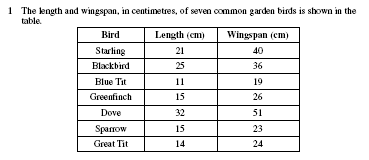 Bishop Hill
Bishop Hill Pigeons and paleoclimate
The Libertarian Alliance blog has posted another one of its "they can't really be asking intelligent children this drivel in an exam" articles - this time on maths.
While the paper is undeniably straightforward, Question 1 struck me for a completely different reason. It shows a table of the lengths of various species of garden bird and also their wingspans.  The first question asks the reader to plot these as a scatterplot and to draw a best fit line through the points. Then they have to estimate the wingspan of a different species, whose length is given.
The first question asks the reader to plot these as a scatterplot and to draw a best fit line through the points. Then they have to estimate the wingspan of a different species, whose length is given.
Easy peasy.
The last part of the question is this:
It is not sensible to use your line of best fit to estimate the wingspan of a pigeon
whose length is 41 cm.Explain why.
The answer is that 41cm is longer than any of the other species in the list. To use rather more technical language, 41cm is outside the range for which the mathematic model has been calibrated. You don't know if your model still works for such big birds, in other words.
This is good sound stuff, and addresses an important scientific point. It's laughably easy of course, but that doesn't make it wrong or anything like that.
But the important point is this. Projecting answers outside the range for which a mathematical model has been calibrated is exactly what paleoclimate researchers do, including the stickmeister himself, Michael Mann. This is from the critique of the Hockey Stick by Burger and Cubasch:
For almost all of the 24 proxies, the range of the millennial variation is considerably larger than the sampled one, with numerous cases of proxies exceeding 7 and more calibration standard deviations (cf. SM). As a consequence, the regression model is extrapolated beyond the domain for which it was defined and where the error is limited.
So my question is this: if we can expect schoolchildren to get this simple bit of statistics correct in an examination that is widely seen as being risibly dumbed down, how come the world's leading paleoclimatologists can't?
Or am I missing something?









Reader Comments (1)